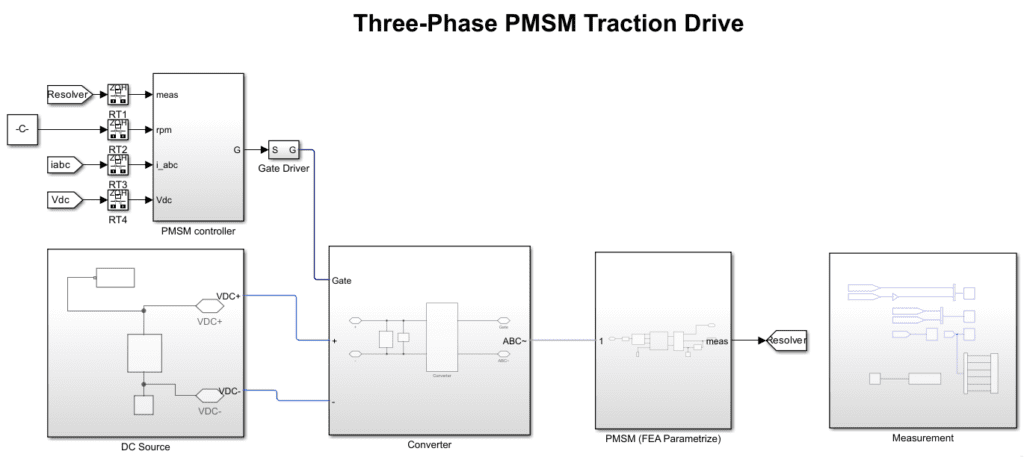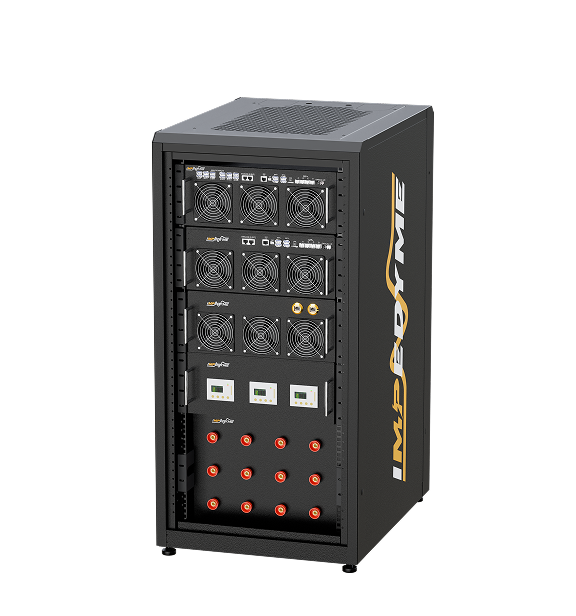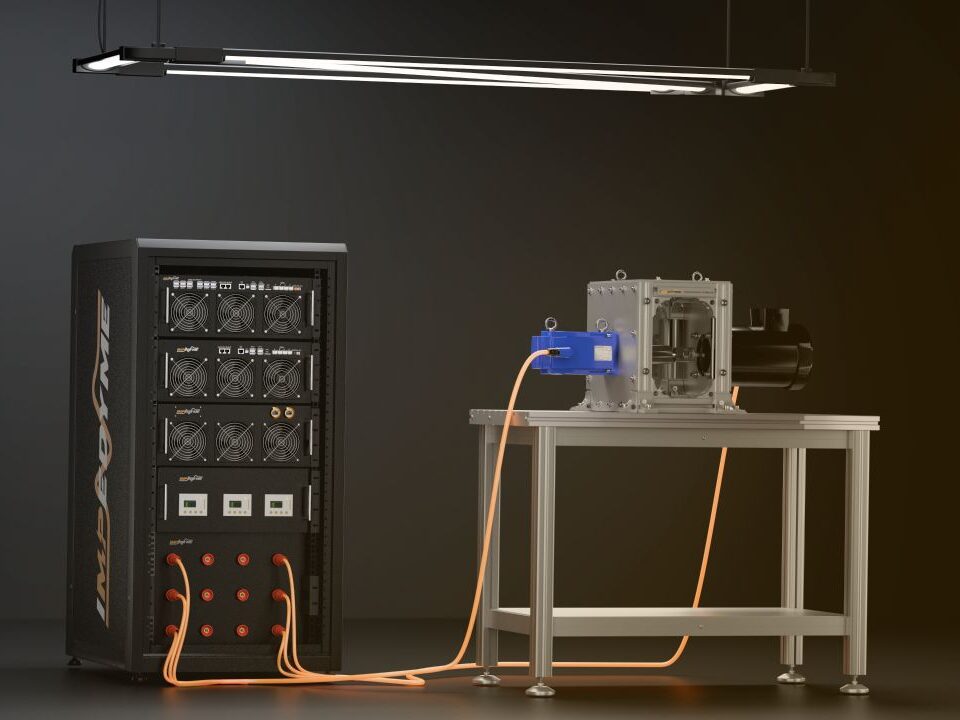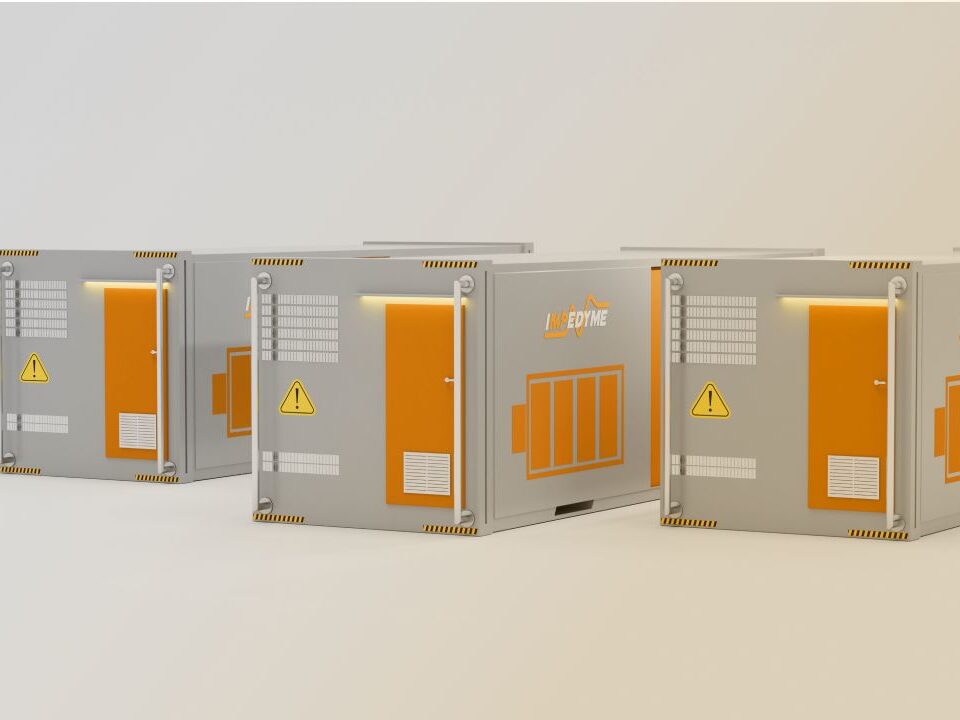
-
 Induction Motor
Induction Motor
-
 Automotive Electrical System Simulation
Automotive Electrical System Simulation
-
 DC/DC Bidirectional Converter
DC/DC Bidirectional Converter
-
 PWM Control for Brushless DC
PWM Control for Brushless DC
-
 BLDC Motor Control and Drive Simulation
BLDC Motor Control and Drive Simulation
-
 Electric Vehicle Fast Charger Simulation
Electric Vehicle Fast Charger Simulation
-
 DFIG Wind Turbine Simulation
DFIG Wind Turbine Simulation
-
 Dual Active Bridge
Dual Active Bridge
-
 EV Dynamometer Test Environment Simulation
EV Dynamometer Test Environment Simulation
-
 Electric Vehicle Simulation
Electric Vehicle Simulation
-
 Three-Phase Grid-Connected Inverter Using Direct-Q…
Three-Phase Grid-Connected Inverter Using Direct-Q…
-
 Three-Phase Grid-Connected Solar Photovoltaic
Three-Phase Grid-Connected Solar Photovoltaic
-
 Grid-Connected Rectifier
Grid-Connected Rectifier
-
 Grid-Tied Inverter System
Grid-Tied Inverter System
-
 Torque Control in a Hybrid Excitation Synchronous …
Torque Control in a Hybrid Excitation Synchronous …
-
 Wye-Delta Starting Circuit
Wye-Delta Starting Circuit
-
 IPMSM-Based Axle-Drive
IPMSM-Based Axle-Drive
-
 Simplified Parallel Hybrid Electric Vehicle
Simplified Parallel Hybrid Electric Vehicle
-
 Simplified Series Hybrid Electric Vehicle
Simplified Series Hybrid Electric Vehicle
-
 Series-Parallel Hybrid Electric Vehicle
Series-Parallel Hybrid Electric Vehicle
-
 Three-Phase Matrix Converter Simulation
Three-Phase Matrix Converter Simulation
-
 Venturini Modulation for Three-Phase Matrix Conver…
Venturini Modulation for Three-Phase Matrix Conver…
-
 Microgrid Frequency Regulation Using Vehicle-to-Gr…
Microgrid Frequency Regulation Using Vehicle-to-Gr…
-
 Three-Phase Modular Multilevel Converter
Three-Phase Modular Multilevel Converter
-
 Field-Oriented Control
Field-Oriented Control
-
 Interior Permanent Magnet Synchronous Generator
Interior Permanent Magnet Synchronous Generator
-
 Permanent Magnet Synchronous Machine
Permanent Magnet Synchronous Machine
-
 PMSM Rotor Angular Velocity
PMSM Rotor Angular Velocity
-
 PMSM-Based Electrical Traction Drive
PMSM-Based Electrical Traction Drive
-
 Maximum Power Point Tracking
Maximum Power Point Tracking
-
 Six-Phase Permanent Magnet Synchronous Machine
Six-Phase Permanent Magnet Synchronous Machine
-
 Synchronous Machine-Based Electrical Drive Simulat…
Synchronous Machine-Based Electrical Drive Simulat…
-
 Single-Stage Solar Inverter
Single-Stage Solar Inverter
-
 Three-Phase Cycloconverter Simulation
Three-Phase Cycloconverter Simulation
-
 Totem-Pole PFC Simulation
Totem-Pole PFC Simulation
-
 Twelve-Pulse Thyristor Rectifier
Twelve-Pulse Thyristor Rectifier
-
 Two-Wheeler On-Board Charger
Two-Wheeler On-Board Charger
-
 Vienna Rectifier Simulation
Vienna Rectifier Simulation
-
 High-Voltage Direct Current
High-Voltage Direct Current
-
 Wireless Power Transfer
Wireless Power Transfer

Comprehensive Documentation for Control of Rotor Speed in a PMSM-Based Electrical Traction Drive
Table of Contents
- 1 Comprehensive Documentation for Control of Rotor Speed in a PMSM-Based Electrical Traction Drive
- 1.1 Introduction
- 1.2 System Overview
- 1.2.1 What is a Permanent Magnet Synchronous Machine (PMSM)?
- 1.2.2 Purpose of the Simulation
- 1.3 Key Features
- 1.3.1 Cascade Speed Control for Enhanced Performance
- 1.3.2 Torque and Flux Control for Optimized Operation
- 1.3.3 Battery-Powered Drive System
- 1.3.4 Field Weakening for Extended Speed Range
- 1.3.5 Fault Detection and Protection Mechanisms
- 1.3.6 Precise Speed Control
- 1.3.7 High Efficiency
- 1.3.8 Regenerative Braking
- 1.3.9 Flexibility
- 1.4 Simulation Objectives
- 1.5 Technical Description
- 1.5.1 System Configuration
- 1.5.2 Control Methodology
- 1.6 Advantages of PMSM-Based Electrical Traction Drives
- 1.7 Applications
- 1.7.1 Electric Vehicles (EVs)
- 1.7.2 Railway and Metro Systems
- 1.7.3 Industrial Machinery
- 1.7.4 Aerospace and Defense
- 1.7.5 Marine and Offshore Applications
- 1.7.6 Agricultural and Construction Equipment
- 1.7.7 Material Handling and Logistics
- 1.7.8 Renewable Energy Systems
- 1.7.9 Research and Development
- 1.8 Simulation Benefits
- 1.9 Summary
- 1.10 Future Enhancements
- 1.10.1 Induction Motor
- 1.10.2 Automotive Electrical System Simulation
- 1.10.3 DC/DC Bidirectional Converter
- 1.10.4 PWM Control for Brushless DC
Introduction
In high-performance electric traction applications, precise control of rotor speed is essential for efficiency and stability. This project focuses on implementing a cascade control structure for a Permanent Magnet Synchronous Machine (PMSM) powered by a high-voltage battery, enabling smooth and responsive speed regulation.

System Overview
What is a Permanent Magnet Synchronous Machine (PMSM)?
The PMSM is widely used in traction applications due to its:
✔ High power density and efficiency.
✔ Fast dynamic response and accurate speed control.
✔ Reduced losses compared to traditional AC induction motors.
✔ Compatibility with advanced control strategies for improved performance.
Purpose of the Simulation
This simulation is designed to:
✔ Implement a cascade control structure for precise PMSM rotor speed regulation.
✔ Optimize torque and flux control loops for stable operation.
✔ Analyze system response under different driving conditions.
✔ Ensure robust performance through real-time fault detection and protection mechanisms.
Key Features
Cascade Speed Control for Enhanced Performance
✔ Implementation of a PI-based speed controller to regulate rotor velocity.
✔ Inner current control loops to ensure fast and stable response.
✔ Compensation for load variations and transient disturbances.
➡️ Benefit: Provides smooth acceleration, deceleration, and speed stability.
Torque and Flux Control for Optimized Operation
✔ Decoupled d-q axis control to manage flux and torque components separately.
✔ Active current regulation to minimize losses while maintaining efficiency.
✔ Enhanced stability under varying load conditions.
➡️ Benefit: Ensures high-performance operation with reduced energy consumption.
Battery-Powered Drive System
✔ Direct connection to a high-voltage battery for traction applications.
✔ Voltage regulation mechanisms to ensure stable power delivery.
✔ Efficient power conversion to minimize energy losses.
➡️ Benefit: Maximizes driving range and battery utilization in electric vehicles.
Field Weakening for Extended Speed Range
✔ Dynamic adjustment of d-axis current to weaken the magnetic field at high speeds.
✔ Maintains efficiency while allowing operation beyond the base speed.
✔ Balances torque production and energy consumption.
➡️ Benefit: Enables high-speed operation without excessive power demands.
Fault Detection and Protection Mechanisms
✔ Overcurrent, overvoltage, and thermal protection to prevent motor damage.
✔ Fast fault detection and automatic corrective actions.
✔ Stable operation under unexpected disturbances.
➡️ Benefit: Increases system durability and ensures reliable traction performance.
Precise Speed Control
PMSM traction drives provide precise and smooth speed control, improving performance and efficiency in electric traction systems.
High Efficiency
PMSMs offer high efficiency and power density, making them ideal for electric traction applications.
Regenerative Braking
Rotor speed control enables efficient energy recovery during braking, improving overall energy efficiency.
Flexibility
PMSMs can operate under a wide range of conditions, making them suitable for various industrial applications.
Simulation Objectives
This simulation aims to:
✔ Develop and validate an advanced speed control strategy for PMSM-based traction drives.
✔ Investigate the impact of cascade control on system response and efficiency.
✔ Optimize control loops for improved speed regulation and dynamic performance.
✔ Enhance fault tolerance and operational safety for real-world applications.
Technical Description
System Configuration
- Input: Electrical power from a high-voltage battery.
- Machine: Permanent Magnet Synchronous Machine (PMSM).
- Control Strategy: Cascade speed control with inner current loops.
- Output: Stable and precise rotor speed regulation.
Control Methodology
✔ Speed Control: Regulates rotor velocity using a PI-based cascade control strategy.
✔ Current Control: Manages torque and flux components via d-q axis control.
✔ Field Weakening: Extends speed range by adjusting the d-axis current dynamically.
✔ Fault Protection: Implements real-time monitoring for system safety and reliability.
Advantages of PMSM-Based Electrical Traction Drives
✔ High efficiency and compact design for electric vehicle applications.
✔ Precise speed control under dynamic and transient conditions.
✔ Extended speed range through field weakening techniques.
✔ Reduced energy losses and enhanced regenerative braking capabilities.
Applications
Electric Vehicles (EVs)
- Passenger Cars: PMSM-based traction drives with rotor speed control are used in electric cars to provide smooth acceleration, regenerative braking, and efficient power conversion. Simulations help optimize performance and energy efficiency.
- Commercial Vehicles: Electric buses, trucks, and delivery vans use PMSM traction drives for reliable and efficient operation, especially in stop-and-go urban driving conditions.
Railway and Metro Systems
- Electric Trains: PMSM traction drives are used in electric locomotives and metro trains for efficient propulsion and regenerative braking. Rotor speed control ensures smooth operation and energy recovery during braking.
- Light Rail and Trams: PMSM traction drives provide precise speed control for light rail and tram systems, improving energy efficiency and passenger comfort.
Industrial Machinery
- Electric Forklifts: PMSM traction drives are used in electric forklifts for precise load handling and efficient operation in warehouses and factories.
- Conveyor Systems: PMSM traction drives provide reliable speed control for conveyor systems in manufacturing and logistics, ensuring smooth material handling.
Aerospace and Defense
- Electric Aircraft: PMSM traction drives are used in electric and hybrid aircraft for propulsion and auxiliary systems. Rotor speed control ensures efficient and reliable operation under varying flight conditions.
- Military Vehicles: Electric and hybrid military vehicles use PMSM traction drives for propulsion, providing high torque and efficiency in challenging terrains.
Marine and Offshore Applications
- Electric Ships: PMSM traction drives are used in electric and hybrid ships for propulsion and auxiliary systems. Rotor speed control ensures efficient operation and energy recovery during braking.
- Underwater Vehicles: PMSM traction drives provide precise speed control for remotely operated vehicles (ROVs) and autonomous underwater vehicles (AUVs), enabling efficient and reliable operation.
Agricultural and Construction Equipment
- Electric Tractors: PMSM traction drives are used in electric tractors for efficient and precise operation in agricultural applications.
- Electric Excavators: PMSM traction drives provide reliable speed control for electric excavators, improving energy efficiency and performance in construction sites.
Material Handling and Logistics
- Automated Guided Vehicles (AGVs): PMSM traction drives are used in AGVs for precise speed control, ensuring efficient and reliable operation in warehouses and factories.
- Cranes and Hoists: PMSM traction drives provide reliable speed control for cranes and hoists, improving safety and efficiency in material handling.
Renewable Energy Systems
- Wind Turbines: PMSM traction drives are used in wind turbines for efficient power generation and speed control under varying wind conditions.
- Hydroelectric Power: PMSM traction drives provide precise speed control in hydroelectric power systems, ensuring efficient and reliable operation.
Research and Development
- Prototype Testing: Simulations are used to test and validate PMSM traction drive prototypes, reducing the need for physical testing and accelerating development.
- Control Strategy Development: Simulations help develop and optimize control algorithms for PMSM traction drives, ensuring efficient and reliable operation.
- Fault Analysis: Simulations help study the behavior of PMSM traction drives under fault conditions, improving system reliability and safety.
Simulation Benefits
By utilizing this simulation, engineers can:
✔ Optimize PMSM speed control strategies for electric traction applications.
✔ Validate motor performance under real-world operating conditions.
✔ Improve overall system efficiency and reliability before implementation.
Summary
This project provides a comprehensive framework for controlling PMSM rotor speed in electric traction applications. By integrating cascade control, field weakening, and real-time fault detection, the system enhances vehicle performance, efficiency, and safety.
Future Enhancements
✔ Implementation of sensorless control techniques for cost reduction.
✔ AI-based adaptive control for real-time performance optimization.
✔ Advanced fault detection and predictive maintenance using machine learning.
The PMSM rotor speed control system in electric traction applications plays a crucial role in achieving efficient, stable, and high-performance vehicle operation. This simulation provides valuable insights into control strategies, performance optimization, and fault protection, contributing to the advancement of electric mobility technologies.






